A Muslim writer travels to a Hindu holy site in troubled Balochistan province, looking for signs of a more peaceful past.
“Arri Allah.”My grandfather’s face was anguished, his thick white eyebrows raised, when he saw the tiny statuette of the goddess Durga that I had taken from his friend’s house. “My god, Annie, what have you done?” I had no answer, but even as a five-year-old I knew I had done something terribly wrong; I had pocketed a deity from a sacred place of worship.
Every year, my grandparents used to take us to Uncle Devraj’s house in Karachi where together we celebrated the annual full moon sighting, known as Diwali. Devraj was Hindu, and my grandfather was Muslim, but they both spoke Sindhi and shared familial roots. Theirs was not a unique story. Unlike in Punjab, where partition brought bloodshed on an unprecedented scale, the Sindh province to the south saw little or no communal violence. The Hindus of Sindh largely stayed behind. Muslim and Hindu families shared bonds that reached back generations; a sense of respect for community prevailed. My grandfather even had his own collection of Hindu icons in his study. Perhaps I’d taken the Durga from Devraj’s house thinking it would be equally at home with him.
But over the years, things slowly began to change. General Muhamad Zia-ul-Haq, who served as president from 1978 until his death in 1988, instituted an era of Islamization that was defined by militants and increasing violence. A series of targeted attacks began on religious minorities. Hindus, Sikhs, Shia Muslims, and Ahmedis, another sect that follows the Quran but is considered non-Muslim in Pakistan, became prime targets. Throughout the 1990s, newspapers regularly carried stories of “sectarian violence.” After Devraj’s death, his family decided to move to Bombay. They came to see my grandmother one last time before leaving. “Things are not the same anymore,” his wife told her. After my grandfather’s death, none of his children claimed the Hindu figures he kept in his office. My grandmother gave away the Durga from his study shelf to an antiques dealer.
Those memories, long forgotten, came flooding back when I decided to make a trip to the Hinglaj—a Hindu holy site located half a day’s journey from Karachi, in the troubled neighboring province of Balochistan. Since partition, Balochistan has seen a number of insurrections against the government, followed by military reprisals. The province makes up a major portion of Pakistan’s coastal belt and has vast natural resources. Yet it remains the poorest province in the country. In recent decades, it has also become a center of Islamic militancy. When I learned that a revered Hindu site was located there, it came as some surprise. It seems that borders and political unrest have done little to dissuade pilgrims from Pakistan and India from tracing an ancient pathway to the resting place of the goddess Durga.

The Hinglaj temple is located in a cave in the Hingol mountains. It is where the goddess Sati’s head (one of the forms of Durga) is said to have fallen from the sky after her body was cut into 51 pieces by Vishnu. “The Hinglaj is to us as the Ka’abah is to you,” said my local Hindu guide, Danesh Kumar, referring to the shrine in Mecca toward which all Muslims direct their daily prayers. Kumar was a local politician and a member of the representative committee of the Hinglaj temple. Clad in a white shalwar kamiz, he fit the bill of both reverent pilgrim and veteran politician. A journalist friend had introduced me to Kumar. He was on his way to pay his respects at Hinglaj and had offered to take me along for the ride.
We were in Kumar’s Hilux, a massive Japanese-made silver truck. Kumar and his family hailed from Las Bela. The district covers the area from the southern town of Hub, where Sindh ends and Balochistan begins. Kumar had lived in Las Bela until a few years ago, when he moved to Karachi for the sake of his son’s education. His son, Vansh Kumar, a precocious ten-year-old, sat patiently in the backseat playing a game on his tablet. “People go to Hingol for vacation, but they should try and learn a little about its history,” the boy told me.
Inside the Hilux, we moved comfortably along the highway leading out of Karachi. With one hand on the steering wheel, Kumar called the private car tracking company where his vehicle was registered, informing them he was soon going to cross into Balochistan. After placing the call, Kumar remembered that this was the first time I was traveling to the province, a fact I had mentioned to him over the phone. He turned to me in the rear-view mirror. “People are very afraid to go into Balochistan,” he said. “You are very brave to go, which is why I decided to take you there myself.”
Traveling into Balochistan was risky. The local English language dailies had quoted military commanders as saying there was no insurgency in the province, just a “few misled militants.” But there were rumors of a full-fledged insurgency in Awaran and other areas not far from our route. Members of media were completely blocked from entering the province, and intimidated when they tried to write about the conflict there. A few months ago, Sabeen Mahmud, a Karachi-based activist and the owner of a local community space called The Second Floor, was shot and killed while driving back after hosting a talk on the disappeared in Balochistan. She had invited two of the most prominent activists campaigning on the issue. Mahmud’s murder sent a clear message to journalists and activists alike: Stay away from Balochistan.
The luxury SUV gives the impression that someone important is inside
We encountered a checkpoint as soon as we entered Balochistan. Soldiers in fatigues were positioned on either side of the road. One approached the window; Kumar rolled it halfway down. “We are on our way to Hingol,” he said briskly. The young soldier’s expression abruptly changed and he nodded and waved us through. Apart from being a reliable off-road vehicle, the Hilux also serves another purpose: In the land of VIP culture, the luxury SUV gives the impression that someone important is inside, someone who might be offended for being stopped. Kumar played the role perfectly with his dismissive manner.
Not long after crossing the checkpoint, we reached Hub, a dusty industrial town that served as a rest stop for travelers passing through. Now, because of Muharram, an important holy month in the Islamic calendar, there were buses carrying passengers to Iran for a month of religious observance. But the route is always heavy with the traffic of trucks carrying goods from Iran and Afghanistan. A major import from Iran is smuggled petrol.
From the main road, Hub looked like a nondescript commuter town. Small hotels dotted both sides of the road. At the end of the road, was a squat structure, incongruously massive. The Jamiat-e-Ulema Islam (JUI) had built this large mosque some years ago. A few blocks from the mosque, on the other end of the road, was another marker of the Jamiat’s presence. Next to the sign reading Mundra—the name of the road in Sanskrit—the Jamiat had erected another identical sign with the Arabic name Seerat, which they found to be more acceptable to their orthodox sensibilities. The JUI, presided over by Maulana Fazlur Rehman, has been attributed with creating the Taliban. Rehman was called “the West’s worst nightmare” by The Guardian.
A short distance away, the JUI presence was even stronger. The walls along an entire stretch were full of graffiti praising Fazal-ur-Rehman. Across the road was an old cemetery that contained the graves of Baloch fighters of the Kalamati tribe, said to have fought alongside Mohammad Bin Qasim. The Arab conqueror had led the armies of Islam in the 7th century to the Lower Indus Valley and sowed the first seeds of the faith in India.
On a hill at the back of the cemetery, a massive sign on the face of a hill read, Jamia Qasim-Ul-Uloom (“The Congregation of the Students of Qasim”), the name of a nearby madrassa. A lesser known fact about Bin Qasim is that he is said to have not only murdered Raja Dahir, the Hindu ruler of Sindh, but to also have raped the ruler’s daughters.
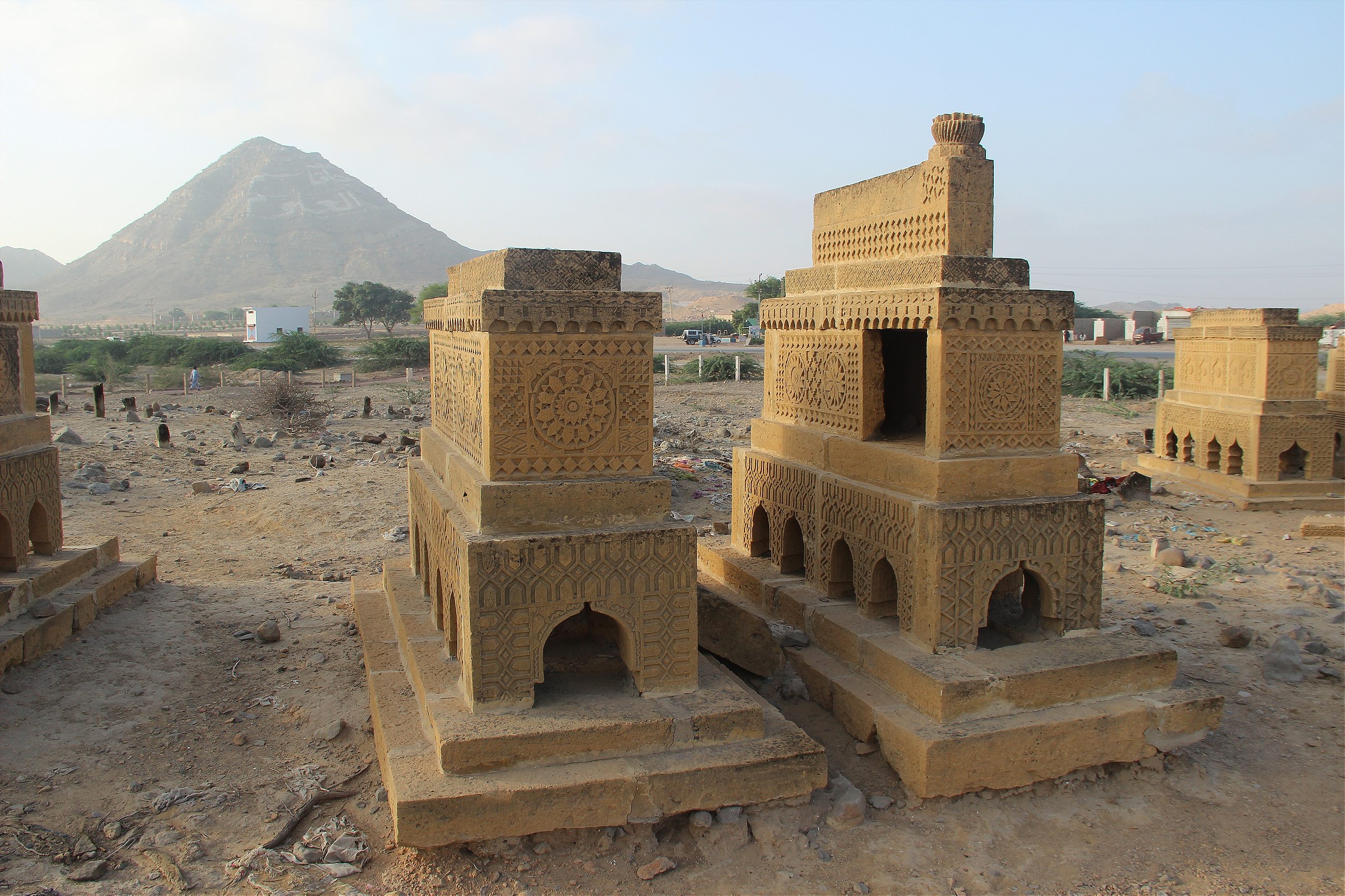
On the other side of a low boundary wall, at the edge of the old cemetery, there was a relatively new row of graves. Though newer, they were poorly made and many were cracked and crumbling. We saw two men packing earth on a muddy grave. They were brothers who belonged to the local area, they told me. The grave was their father’s, who had died two years ago. The brothers had dug his grave and buried him. Since then, they came every year during Muharram to build on it. Last year they added a tombstone and this year they brought the thin bricks that would form the boundary. It was a stark contrast between the glorious legend of Qasim being celebrated by the JUI and the poverty being experienced by the people living in this place.
We wished the brothers luck and Kumar suggested we get back on the road. Minutes later were back on the highway again. Driving through Sonmiani, we passed a military firing range. “All the missile tests are carried out here,” said Kumar, as we passed the barracks covered in barbed wire. I spotted few locals along the way, their homes fragile next to the enormous military installations. A herd of goats slowed us down and then a young camel trotted past.
Every so often the sea became visible from the highway, a glimpse of azure as rich as the expanse of sky above. Then, just as quickly, it dipped away behind the rocky landscape. In the town of Winder, Kumar stopped to pick up clay bowls of yogurt for the temple. A small boy selling boiled eggs arranged along the rim of an aluminum tray walked past as we waited, calling out with a voice that boomed improbably out of his skinny frame.
Across the road, a lone Hindu pilgrim sat on the pavement. He had an intense face, black shining eyes, a sharp nose on a weathered face, framed by a thick hennaed beard. He could have been wandering the coastline for months or thousands of years. He was a Jogi, Kumar explained. The Jogis are the oldest pilgrims to the Hinglaj, their journeys immortalized in the poetry of Shah Abdul Latif Bhitai, which nearly every Pakistani knows. They belong to a special tribe of people, mendicants who band together and wander the land in search of spiritual knowledge. Once, they were respected and revered by the people, who offered them food and sometimes money in support of their lifestyle. But today, they get by giving camel rides at the beach or touring the streets with trained monkeys.
Shah Abdul Latif Bhitai was one of the most famous pilgrims to the Hinglaj. According to local lore, his father, Shah Habib, once came across a group of Jogis. Habib asked where they were headed. They were on their way to pay respects to the Hinglaj, they told him. The journey from Thatta to Hinglaj was arduous, a route that took days, even weeks, and passed through scorching desert and dense jungles, with bandits along the way.
Later, Habib repeated the encounter to his son, Latif. “The Jogis are dishonest, and dishonest is their quest,” said Shah Habib. “When enlightenment can be found within oneself, why do the Jogis pretend the pilgrimage all the way to Hinglaj?” Latif listened to his father and responded: “They are honest, and honest is their quest, for I myself have been to meet the Mata”—the Mother.
When H.T. Sorley, a British Imperial Officer, was posted in the Lower Indus in the 1800s, he was immediately enchanted with the life and work of the poet who had lived a century before. Sorley found Latif to be “contemplative and thoughtful, fond of loneliness and loved to wander by himself.” Latif, Sorley wrote, “found pleasure in passing time with holy men and fakirs in an effort to understand the ideals which they strove to interpret.” The most stunning visual in Latif’s poetry is that of a Jogi, his hair loose around his shoulders, standing on top of the mountain of Hinglaj.
Back on the highway, I watched the vistas passing outside the window. They felt unfamiliar. Here and there were cliffs with sandy slopes. The earth looked silvery pale. To our left were marshes and low trees, Tamarisk and Baboor, ancient small trees with twined trunks, surrounded by the swirl of fine dust. Back in the times when the pilgrims made the journey on foot, they were said to carry funeral shrouds with them, for the path ahead was long and arduous and the chances of coming back alive live were slim. If they died on the way, it was not uncommon for their bodies to be buried—and not cremated, even if they were Hindu—and for a tomb to be erected at the site, so they too could be revered for their pilgrimage.
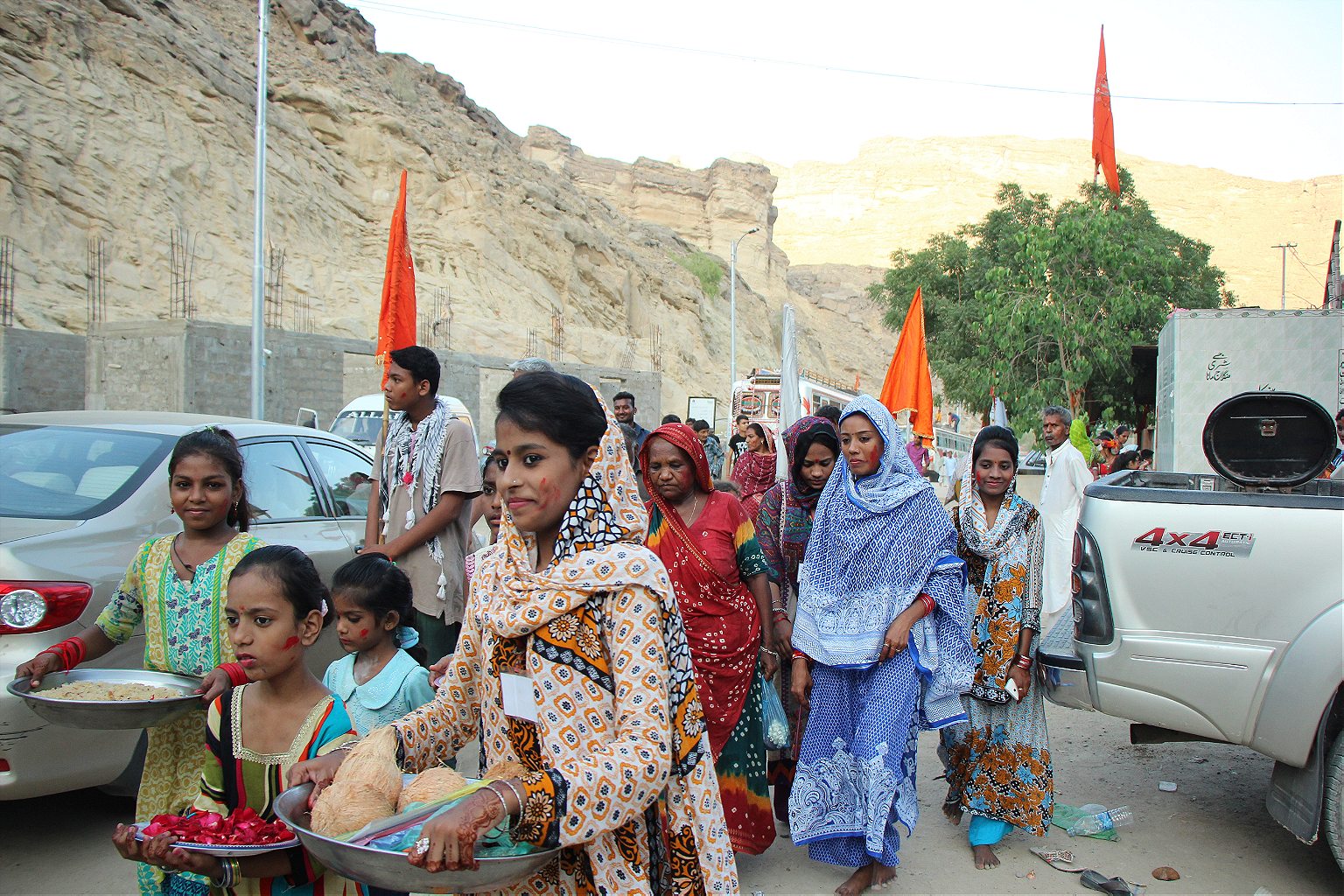
One of the first rituals in the pilgrimage was a climb up a volcano for a prayer to Shiv, the great ascetic god of the Hindus. In the distance, beyond the marshy plains, we could see the silver peak of the Chandar Goop, a barren volcano with a long, sloped face dotted with human forms. “There are many pilgrims here,” said Kumar as we pulled in beside several parked buses in a sandy makeshift lot.
There was a group setting off from their bus, barefoot men wrapped in white cloth on their way to join a much larger group, already on the summit. I sat in the car contemplating whether or not to go up. It was a blistering 104 degrees Fahrenheit outside. “People are known to faint while climbing,” Kumar said, “so on special festival occasions when there are large crowds, we arrange for ambulances.” I hesitated, but curiosity won and I decided to climb to the top.
The ground was a mushy clay that gave little traction. Along the way, there were wooden pegs in the ground every few steps for support. The going was slower than I had expected and we soon fell behind the group who had just set out. Halfway up, I began to feel lightheaded and had serious doubts about my decision, but my pride was at stake now. I pushed on. The group of pilgrims at the top, now about thirty people, were seated along the rim of the mouth of the volcano and smiling at us as we approached, seemingly amused at my struggle. Finally, we made it to the top and settled on a spot along the rim.
At the summit was a shallow basin of mud that was bubbling in places. The pilgrims performed a series of prayers and sang bhajans, Hindu devotional songs. In the wet clay at the edge of the rim, devotees had sculpted lingams. They smeared their bodies with the sacred ash prayed to the clay forms to protect them as they traversed the last phase of their journey towards the temple. They had traveled three days and were finally ready to continue on to their destination, Hinglaj. We descended the volcano with them, and again I found myself falling behind the barefooted men, stumbling in my sneakers that were now full of ashy mud.
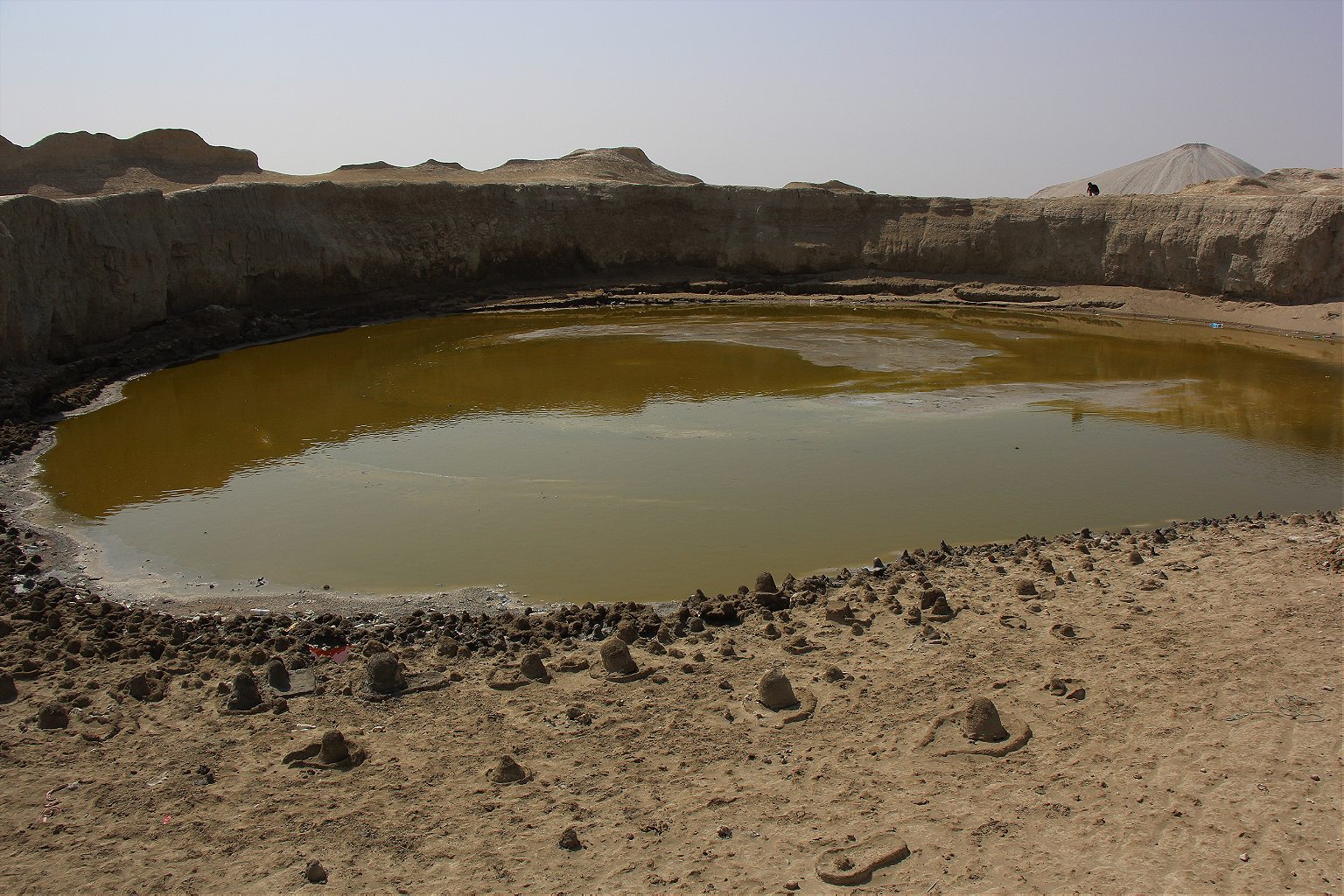
I climbed into the Hilux, feeling guilty as I tracked mud onto the pristine mats inside, despite Kumar’s assurance that it would be easy to clean. “We should get moving,” he said, “it’s getting late. I didn’t think you would climb all the way to the top.”
We were soon on our way to Hinglaj, and our trusty vehicle quickly pulled out far ahead of the heavily loaded buses carrying pilgrims. Mountains of sand now gave way to sharp stony hills. The foliage here was thicker. Hingol is perhaps the most lush patch of greenery between Hub and Jiwani near the Iranian border. It’s a landscape of mountains intertwined with gorges cut by the Hingol river. We were driving alongside it as we made our way to the mountain where the temple was located. “There are giant crocodiles here,” Kumar told us. “But they come out when it gets a bit cooler.”
From the river, the Hilux made its way across a massive bridge. Built very recently, the bridge had eased the passage for the pilgrims. Up until five or six years ago, I was told, there had been no bridge. The pilgrims often spent several days sleeping on the cliff, waiting for the water levels to go down before they could cross to the temple.
The bridge ended in a gravel parking lot at the base of a sloping hill where a number of buses were parked. I tried to spot the group of pilgrims we had met at Chandra Goop, but I couldn’t find them. Just below the entrance to the cave, a stretch of open ground on the slope was home to a small rest-stop built for weary travelers, complete with rooms to rent, a communal food area, and solar power for basic electricity needs. The whole atmosphere here was festive and relaxed.
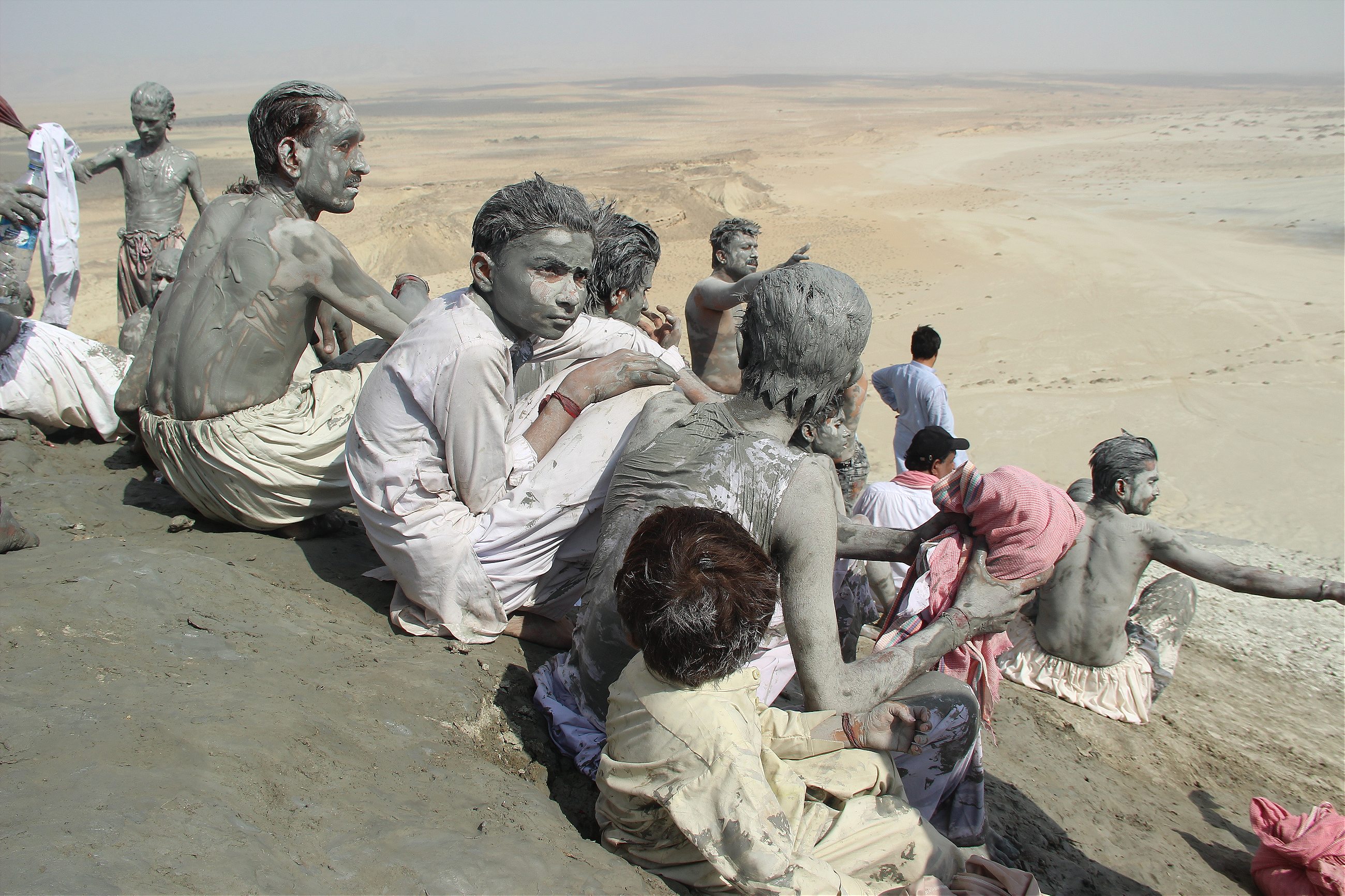
The Navratri, the nine-day moon celebration, had just ended. There were stalls of souvenirs: brightly illustrated depictions of the goddess alongside homemade potato cutlets. The area was strictly vegetarian. Kumar and the group stopped in a large veranda where lentils, vegetable curry, and rice was served on banana leaves. After lunch, we made the short walk to the cave. A bright red banner depicting the many forms of Durga announced the entrance to the temple.
The temple lay within a natural cave carved into the side of a mountain. Upon entering, the light dimmed and a cool dampness permeated the air. Despite the throngs milling about, there was a stillness to the atmosphere. As my eyes slowly adjusted to the change in light, I saw what looked like a wall of eyes. There were shallow indentations, where the rock face had been hollowed out by dripping water, each cavity roughly in the shape of an eye: the Durga’s gaze. The goddess I had once stolen from my grandfather’s friend was now staring down at me.
Deeper inside, along a low ridge in the cave, was the place where the Durga is said to have made an appearance in all her fiery glory. There was a statue of her here, and devotees offered prayers as they bowed before the goddess.
Finally, we reached a small man-made structure that housed the epicenter of the temple. Above the entrance were three brass bells. I stopped and rang all the bells before continuing inside behind the other pilgrims. The cave’s rough stone floor had been replaced by a smooth marble floor with the most ornate statue of Durga on a raised platform at the center.
There were devotees in various positions of prayer. A man with a handkerchief tied to his forehead, kneeled on the floor with his eyes closed. On the platform, young men and women were busy taking a group selfie with Durga. An elderly woman waiting her turn to pray told me she had come from Karachi. Her house in the city had been robbed one night and all the family belongings had been stolen. She had come not so much to ask for anything, as to seek solace at the temple. “It is so peaceful here. I am going to bring all my children with me next time,” she said, almost teary eyed.
Kumar introduced me to Gopal Gire, the head priest responsible for management at the Hinglaj. Gire, an intense looking man with a sharp nose and gleaming eyes, had been serving at the temple for nine years. A former communist, he long refused to believe in Durga. “How can a woman riding a lion offer anyone protection?” he would ask his friends. A series of personal tragedies, including the loss of two of his children, led Gire to find solace in faith. He became a bhakt, a devotee, and spent forty days and nights in prayer to the Mata and ended up at the temple. “These things happen suddenly. You discover one day that you have become a dervish,” he said.
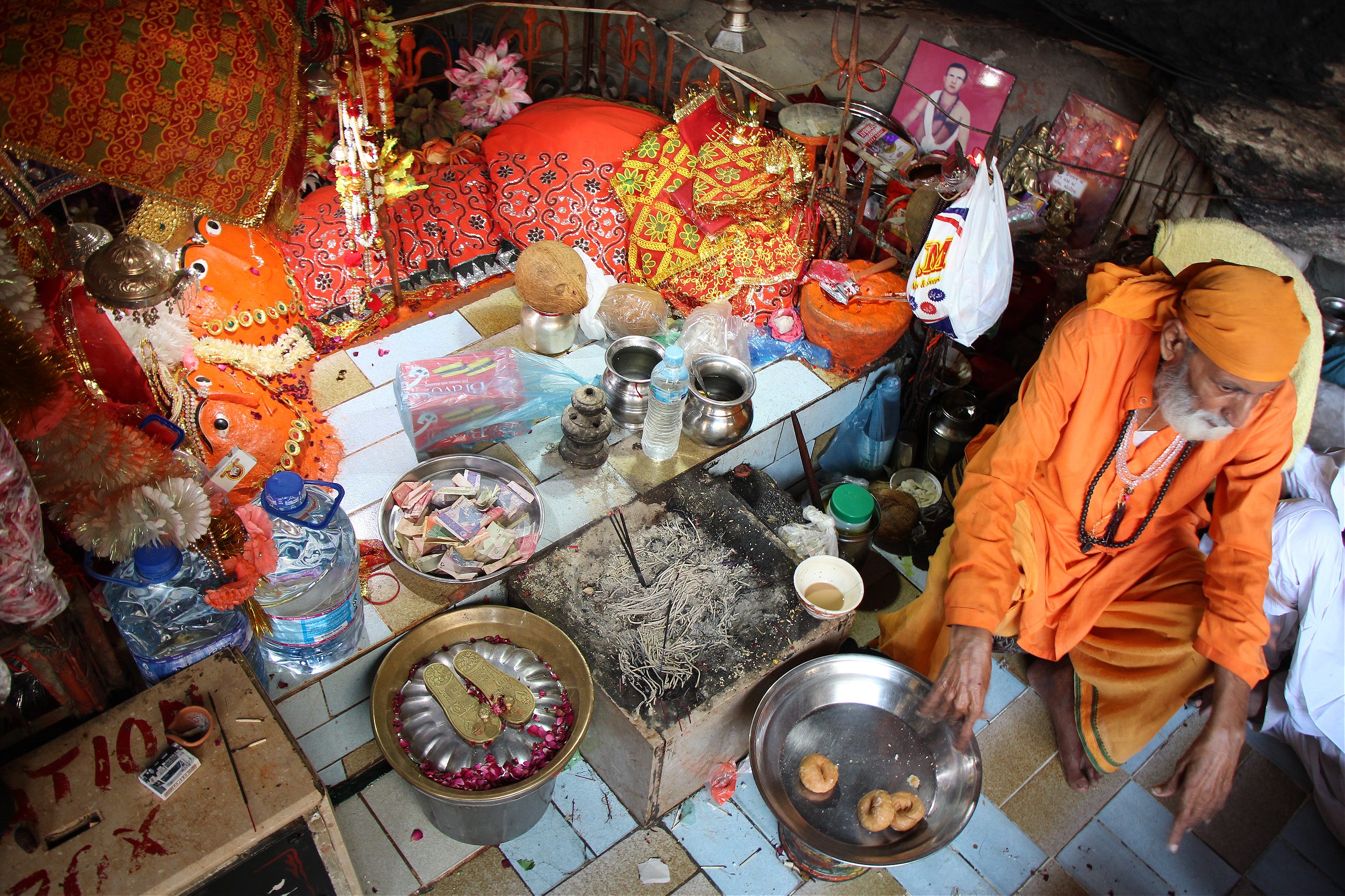
Beside Gire, under a low wall, were two perfectly round smooth stones. These were the twin faces of Durga. The faces had been painted in bright hues with lines for the mouth and eyes and nose. Her expression was serene as she lay in perfect repose. I fought the urge to reach out and touch the stones. In a square basin below the stones, incense sticks were burned. The basin was full of ash. Some of the devotees brought water bottles and Gire poured some of the ash from the incense into the water.
The legend goes that when Shah Abdul Latif Bhitai, the poet saint, arrived before Durga, he found two bowls of milk at her feet. The milk bowls were said to have been left there as offering by the pilgrims. “Naani Maa, why don’t you drink the milk,” Latif asked the goddess. “Why are you sleeping?” Durga is said to have reached over and drunk the milk from each bowl and then reclined and lay on the floor of the cave, as she is seen there today, perfectly in repose. Durga then created an opening in the wall of the mountain. Latif entered, disappearing into the darkness. When he walked out again, he was back in his home, Thatta, two hundred miles away. Latif’s life is inextricably tied to the legend of Hinglaj. In making the pilgrimage, Latif had laid claim to the revered site, he had made the legend his own, and in turn Hinglaj had made Latif a part of its lore.
I thanked Gire and exited the cave with a beautiful story to take home. Outside, in the chasm between the mountains, countless pilgrims had tied tiny bits of brightly colored cloth—their own stories now tied to the legend of the Hinglaj.
A man dressed in white, walking with a young boy, caught my eye. He had a cloth tied around his head, and an impressive rugged face with large eyes and a strong nose. His name was Babu Daagarzai Baloch of the Zikri tribe. He told me there was a long tradition in his family that when a son was born, the child was brought by the father to make an offering of a special sweet prepared at home called Roth. He had come to say his thanks to the goddess for a son. He called her Naani Pir—the revered grandmother. Baloch had known where to go based on a vivid childhood memory when his father brought him to come see the Naani Pir.